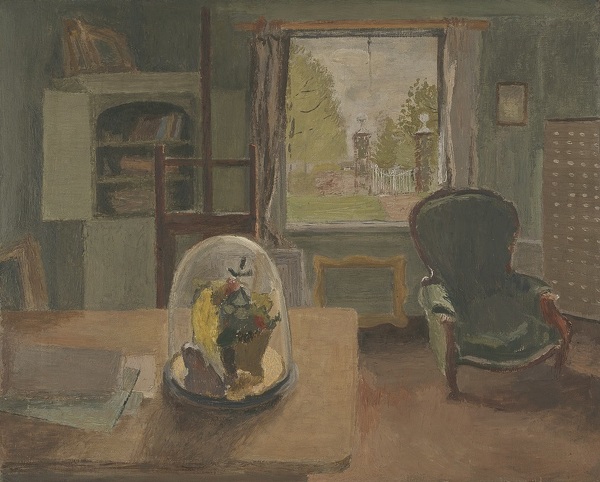

Mary Potter (1900-1981):
Country Studio, 1944
Framed (ref: 9983)
Oil on canvas
25 x 33 in. (63.5 x 83.8 cm)
See all works by Mary Potter oil interiors women Fifty Works by Fifty British Women Artists 1900 - 1950
Provenance: Collection of Chris Potter
Exhibited: 50/50; Fifty British Women Artists 1900 – 1950, Worshipful Company of Mercers (3rd December 2018 - 23rd March, 2019); The Stanley & Audrey Burton Gallery, University of Leeds (9th April, 2019 - 27th July, 2019).
Country Studio is a wartime picture, produced while Mary Potter was living temporarily at Berwick Hall, (a large house near Topplesfield in Essex), with her two children and husband Stephen.
Something of this make-do situation can be felt in this picture. The easel announces that the room is a studio, and there are also papers on the table, empty frames and the back of a canvas in view. But the room is very obviously a comfortable living room – possibly a dining room – put to other use. It has a large, not quite square window which appears to be open as it offers an uninterrupted view of the drive leading to a white gate between two pillars with stone balls on top and an avenue of trees beyond. The whole scenario offers a very interesting exercise between near and far – notice that the nearby edge of the picture table comes right up to the very forefront of the picture plan. Its horizontal line is echoed in various other horizontals elsewhere and is challenged by the verticals found in the easel, in cupboards and the sides of the window. The room is dusky, its colours a combination of cool greens and warm browns and pinks, all held together by the addition of white in order to match and marry tonal values. Nevertheless, the dominant ingredient is light, which touches the armchair and spreads across the floor and table, highlighting the glass dome and the view outside. These two seem to call to each other, setting up a tension that keeps us in the room while at the same time attracted to the lightness and freedom conveyed by the view. At moments, the entire room seems to act as a frame for this view through the window, but in fact it is this toing and froing that holds our attention – the conjoining of inner and outer.
Commentary by Frances Spalding, art historian, writer and curator specialising in twentieth-century British art, biography and cultural history. She is former Editor of the Burlington Magazine.
 Unsung Heroines
Unsung Heroines Private collection
Private collection



